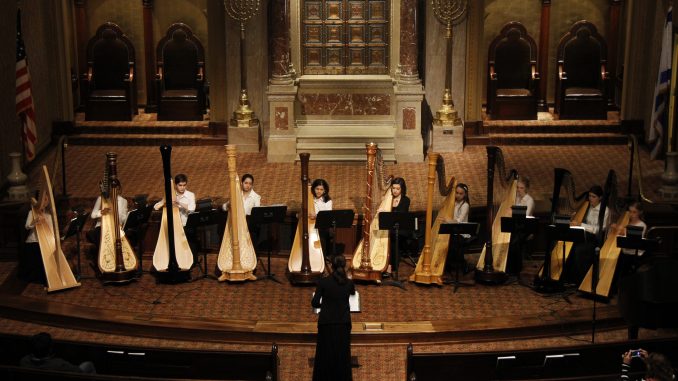
There’s a joke among musicians, Mark Huxsoll says, that Americans would be hard pressed to find a respected doctor who didn’t learn how to play an instrument at some point.
That’s why Huxsoll, the director of Temple Music Prep at the Boyer College of Music and Dance, thinks the programs it offers are particularly important to the Philadelphia community – the various organizations like Youth Chamber Orchestra and Philadelphia String Project allow the city’s youth to academically and creatively flourish in collegiate-level spaces. The Youth Harp Ensemble, one such organization through Temple Music Prep, presents a highly specialized opportunity for young musicians to grow.
Youth Harp Ensemble, part of the Center for Gifted Young Musicians, was formed in 2008 within Temple Music Prep by its conductor, Kimberly Rowe, and acclaimed harpist Elizabeth Hainen of the Philadelphia Orchestra. Rowe previously conducted a harp ensemble comprised of only her own students, but said she wanted to open the opportunity to more students in the area. Currently, there are nine students in the ensemble between ages 12 and 18. The students commute to the Center City campus on select Saturdays every semester to practice together.
Allison Janney and Ruth Boyajian, two high school seniors in the Harp Ensemble, were Rowe’s private students before she suggested they join the group. Both students called the ensemble formative to their musical interests and academic goals. The group united them with similarly driven young harpists, they said.
“Unlike a violin student, I can’t find five or six other [harpists] in my town,” 18-year-old Janney, an Allentown, Pennsylvania resident, said.
The Harp Ensemble gave her a sense of community. Now, Janney is considering Temple’s Boyer College a top choice for her intended harp performance major. Seventeen-year-old Boyajian, who lives in New Jersey, hopes to study music and business, and continue playing in a harp ensemble – she’s considering studying at Vanderbilt University. When she visited the campus, a member of the Vanderbilt harpist group was a former Harp Ensemble member.
“Even if you don’t notice it at the time, people will connect through [the Harp Ensemble], just through going through the same program,” Boyajian said of the harpist community she’s found.
The dedication students show, Huxsoll said, is unparalleled. Along with a price of $595, the instrument itself presents additional burdens.
“The students who participate all have access to a harp, [and obtaining one] is often quite a drain on the family,” Huxsoll said. “We see a number of families where, if their student does harp, that’s it. The needs are not so much to come to school and play it, but to have daily, consistent access to it to have time to practice.”
This consistent practice is often individual out of necessity, Huxsoll added. Typically, a symphony orchestra will have only one harpist – many of the musicians are accustomed to practicing alone. The Harp Ensemble gives young players a chance to approach their musical learning in a more social environment – with competitive drive.
“Philadelphia, historically, is a big arts town,” Huxsoll said. “We are in a unique position in that we are the only program that’s based at the Boyer College of Music and Dance and based at Temple University. That can matter and be a difference over any of the other organizations that integrate with the community. Our community music scholars are studying in the same rooms that a doctoral student or any other degree candidate studies.”
The connection with university instructors and professional players is a great advantage to students, program leaders said, something the students “wouldn’t have outside the Temple program,” Rowe said. Rowe is not only a professor at Boyer, but also the editor of Harp Column Magazine. Hainen, Huxsoll said, is “big stuff – she’s like if you were doing a hip-hop concert and Jay-Z was there, you would come.”
Students can participate in studio courses that Hainen teaches independently as well, giving them the opportunity to participate in additional high-level learning.
“In terms of development, what’s exciting to see is when someone joins the group at a younger age with no experience, and then becomes stronger and starts to play out and become a real contributor,” Rowe said in an email. “It’s really rewarding to watch that progression, and I guess I would say that’s what I’m most proud of.”
And it’s not only playing the harp that students develop a great aptitude for – there are a number of practical skills both Huxsoll and Rowe said are intrinsic to music education.
“We’ve had several very talented students go on to pursue music at major schools and conservatories around the country,” Rowe said. “But not everyone wants to do that of course, and the ensemble still provides essential skills applicable to any career path. We’ve all heard stories about how music education helps foster important life skills, such as time management, goal setting, confidence, etc., and the harp ensemble is just one example of seeing that in action.”
Erin Edinger-Turoff can be reached at erin.edinger-turoff@temple.edu or on Twitter @erinJustineET.



Be the first to comment